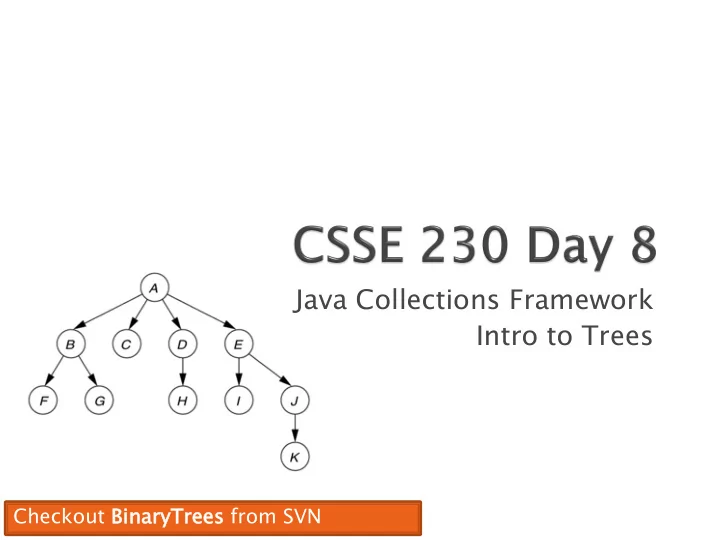

Java Collections Framework Intro to Trees Checkout BinaryTrees ees from SVN
Pascal partner evaluation in Moodle due Weds night Hopefully you are close to finishing either Hardy or Evaluator by now and gotten a start on the other one. ◦ If n not ot, i it t is ti s time to ge to get t mov oving!
Rose is teeming with teams
No prima donnas ◦ Work together or divide work equitably ◦ Working way ahead, finishing on your own, or changing the team’s work without discussion: is selfish harms the education of your teammates may result in a failing grade for you on the project No laggards ◦ Coasting by on your team’s work: is selfish harms your education may result in a failing grade for you on the project
I’ll assign an overall grade to the project Grades of individuals will be adjusted up or down based on team members’ assessments At the end of the project each of you will: ◦ Rate each member of the team, including yourself ◦ Write a short Performance Evaluation of each team member
Excel ellen ent—Consistently went above and beyond: tutored teammates, carried more than his/her fair share of the load Ve Very g good ood—Consistently did what he/she was supposed to do, very well prepared and cooperative Satis isfactory ry—Usually did what he/she was supposed to do, acceptably prepared and cooperative Ordin rdinary—Often did what he/she was supposed to do, minimally prepared and cooperative Margin inal—Sometimes failed to show up or complete tasks, rarely prepared De Defic icient—Often failed to show up or complete tasks, rarely prepared Unsati tisfa facto tory—Consistently failed to show up or complete tasks, unprepared Su Superfici cial al—Practically no participation No o show how—No participation at all
Ratings must be supported with evidence Performance evaluations document: ◦ Positives ◦ Key negatives Performance evaluations are standard procedure in industry ◦ Why might that be the case?
Document dates and actions: ◦ Jan. 1, stayed after mtg. to help Bob with hashing ◦ Jan. 19, failed to complete UML diagram as agreed List positives: ◦ The only way to help people improve! List key ey negatives: ◦ Not all ll negatives ◦ Egos are too fragile for long lists, can’t fix everything at once anyway
Keep a journal about the project I’ll grade your evaluations Your evaluations may be shared with the team member being evaluated. Don’t keep your feelings to yourself Get me involved if your team can’t work out an issue!
Review: Java Collections Framework and Iterators Introduction to trees Begin binary tree implementation Today or tomorrow will include some work time
Q1 Q1 Available, efficient, bug-free implementations of many key data structures Most classes are in java va.uti til Weiss Chapter 6 has more details about collections
Q2 Q2 Done with an interface, e.g., java. a.ut util. il.Colle llect ctio ion A “factory method”
Q3 Q3 In Java, specified by java.util.Iterator<E> ListIterator<E > adds:
ag can be any Collection of Integer s The Java compiler translates the above into this:
addAll(Collection other) containsAll(Collection other) removeAll(Collection other) retainAll(Collection other) toArray()
Handy java.util.Arrays utility methods: See lections Collections for similar methods on List s List
Q4 Q4 weiss.util ◦ Shows "bare bones" possible implementations of some of the classes in java.util ◦ Illustrates (just) the essence of what is involved in implementation weiss.nonstandard ◦ Some other data structures, not found in java.util ◦ Some alternate approaches to some classes that are also in weiss.util See links from day 8 and 9 of schedule
Introduction and terminology
Class hierarchy tree (single inheritance only) Directory tree in a file system
Q5-7 Q5 A collection of nodes Nodes are connected by directed edges. ◦ One special root node has no incoming edges ◦ All other nodes have exactly one incoming edge One way that Computer Scientists are odd is that our trees usually have their root at the top!
Q8 Q8 Parent Child Grandparent Sibling Ancestors and descendants Proper ancestors, proper descendants Subtree Leaf, interior node Depth and height of a node Height of a tree
Q9-14 Q9 14 The heigh ight of of a t a tree ee is the height of its root node. Which is larger, the sum of the heights or the sum of the depths of all nodes in a tree?
A Binary Tree is either ◦ empty ty, or ◦ consists ts of: a distinguished node called the root, which contains an element, and A left subtree T L , which is a binary tree root A right subtree T R , which is a binary tree T L T R
Let’s implement a BinaryTree<T> class including methods size() , height() , duplicate() , and contains(T) .
Recommend
More recommend